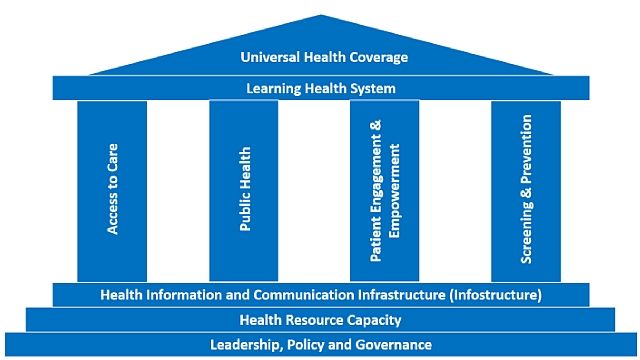
Scaling-up digital health to help achieve universal health care
The 1978 Declaration of Alma-Ata affirmed health as a fundamental human right, and the World Health Organization (WHO) has endorsed Universal Health Coverage (UHC) as the means to achieve this goal of ‘health for all’. UHC aligns with Goal 3 of the new Sustainable Development Goals, and encompasses health promotion, education, prevention, protection, treatment, and palliative care.
As a recent systematic review affirmed, modern information and communication technologies (ICT) hold great promise to improve access and quality of health care delivery. The “digital health” strategies being initiated with ICT are known by various names including eHealth, mobile health, and telehealth.
However, the integration of digital health in low and middle income countries, regions, and communities is uneven and dependent on the local needs, context, and people.
A recent paper1 proposes an evidence-informed “resilient health system framework” as a guide for policy makers to scale-up digital health in their national, regional, and global efforts to support UHC, with a particular focus on low and middle income countries. The paper transpired from an international collaboration between clinicians, academics, and health system and technology leaders gathered at the Global Telemedicine 2015 conference in Toronto, Canada.
Resilient health system framework
The framework structure is shown above, and each element is discussed in turn, beginning with the foundation.
The foundation
The framework is built on three interlocked platforms which together support the entire health care system:
- Leadership, policy and governance – Accountable leadership, powerful policy, and effective governance are critical to achieving health equity.
- Health resource capacity – The success of digital health is contingent on establishing the necessary capacity and resources to build, use, and support access to high quality health services, and harvest useful information in the health system.
- Health information and communication infrastructure (infostructure) – The infostructure is an important instrument of policy as it operationalizes and rationalizes the design and focus of digital health investments that enable the country to achieve its health system goals and objectives, including UHC.
The pillars
The pillars represent dependable health service delivery arms, which both generate and consume digital health information to meet the health needs of the population, and support the resilient health system framework in achieving UHC. These pillars include:
- Access to care – Digital health provides new avenues to improve access to care and enhance continuity of care. These approaches transcend geography to optimize health service delivery by improving both the quality and cost effectiveness of health care.
- Public health – Public health refers to all organized measures by public or private organizations to prevent disease, promote health, and prolong life among the population as a whole. As such, public health examines the total system of care and is not concerned only with the eradication of one particular disease.
- Patient engagement and empowerment – Patient engagement can be defined as “actions individuals must take to obtain the greatest benefit from the health care services available to them”. Digital health creates opportunities for patients to improve their own health by becoming more aware of and involved in self-care and decision-making in treatment approaches.
- Screening and prevention – Digital health holds significant promise for disease screening and prevention in low and middle income countries. Benefits of digital health to support disease screening and prevention include timely access to health and patient information, early and rapid case detection, disease surveillance and population health.
The ceiling
The Learning Health System (LHS) constitutes a powerful and overarching canopy to support all aspects of UHC implementation and continuous improvement in health service delivery. The LHS paradigm denotes a health system where new insights and knowledge are continuously generated using information and evidence accumulating within the system itself.
The roof: Universal Health Coverage
All parts of the framework – from the foundation to the pillars and the ceiling – work synergistically towards supporting the roof structure. Optimizing existing ICT infrastructure and making strategic new investments in digital health solutions contribute to the acceleration of achieving UHC.
The health system captures the evidence and works towards UHC through iterations in optimizing access, quality and productivity of care delivery universally. The resulting solutions will lead to innovative models from low and middle income countries to high income countries and vice versa.
Measuring UHC with ICT-enabled monitoring systems can also enhance evidence-based health policies and decision making with more reliable and sufficient data in formats and frequencies that ensure better health systems performance and prioritization of efforts.
Article and header image source: The paper Applying the Resilient Health System Framework for Universal Health Coverage is distributed under the terms of CC BY-NC 4.0.
Reference:
- Ho, K., Al-Shorjabji, N., Brown, E., Zelmer, J., Gabor, N., Maeder, A., … & Abbott, P. (2016). Applying the Resilient Health System Framework for Universal Health Coverage. Studies in health technology and informatics, 231, 54-62. ↩
Also published on Medium.






